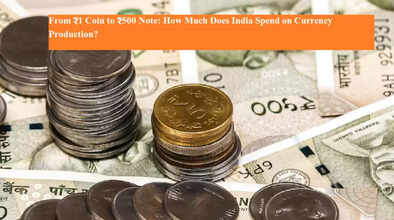From ₹1 Coin to ₹500 Note: How Much Does India Spend on Currency Production?

Every coin and note in India comes with a production cost, which often exceeds its face value. While coins are expensive to mint, printing notes also involves substantial expenditure. Here’s a detailed look at how much the government spends to produce coins and currency notes.
Who Makes Coins and Notes?
-
Coins: Minted by the Government of India at Mumbai and Hyderabad mints.
-
Notes: Printed by the Reserve Bank of India (RBI), via its subsidiary RBI Note Printing Pvt. Ltd. at two currency presses.
Coin Production Costs
Even though ₹1 coins seem small, their emotional and practical significance remains high. Introduced in 1992, these coins cost more to produce than their face value. According to 2018 RTI data:
| Coin Value | Production Cost |
|---|---|
| ₹1 | ₹1.11 |
| ₹2 | ₹1.28 |
| ₹5 | ₹3.69 |
| ₹10 | ₹5.54 |
-
Coins are made from stainless steel.
-
Example: ₹1 coin – diameter 21.93 mm, thickness 1.45 mm, weight 3.76 grams.
-
Production costs have likely increased since 2018 due to inflation.
Minting Decline:
The number of coins produced has fallen over the years, likely due to the rise of digital payments like UPI.
-
₹1 coins minted: 90.3 crore (2017) → 63 crore (2018)
Note Printing Costs
RBI prints notes from ₹2 to ₹500 (and previously ₹2000). Costs vary based on denomination:
| Note Value | Cost per 1,000 Notes | Cost per Note |
|---|---|---|
| ₹10 | ₹960 | ₹0.96 |
| ₹100 | ₹1,770 | ₹1.77 |
| ₹200 | ₹2,370 | ₹2.37 |
| ₹500 | ₹2,290 | ₹2.29 |
| ₹2000 | — | ₹4 (discontinued) |
-
₹2000 notes, introduced post-demonetization, cost around ₹4 per note, but printing has stopped and they are being gradually phased out.
Key Takeaways
-
Coins cost more than their face value to produce, especially smaller denominations.
-
Printing higher-value notes is cheaper relative to their face value, making currency notes cost-efficient for the government.
-
Digital payments are reducing coin usage, which may decrease production costs over time.

